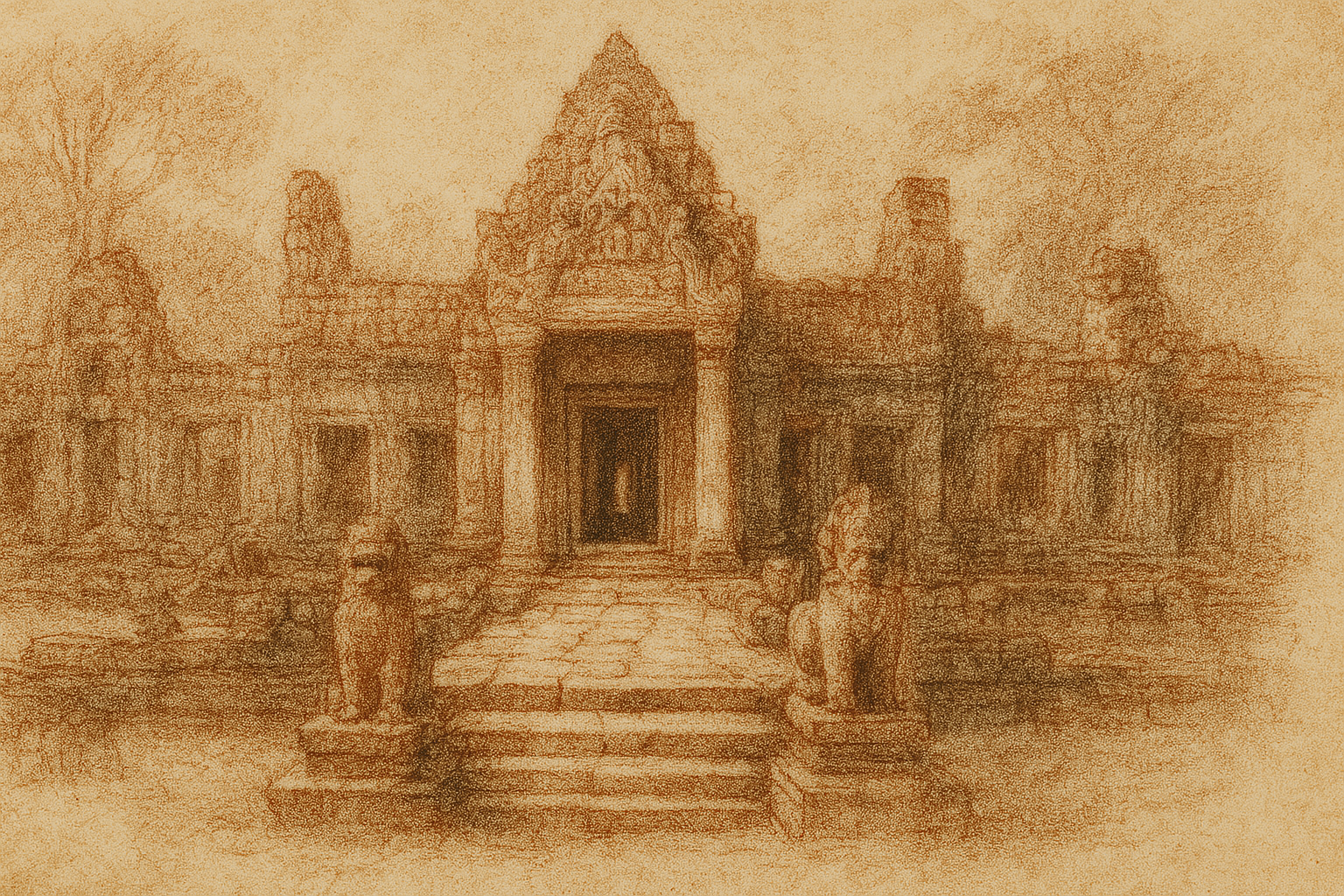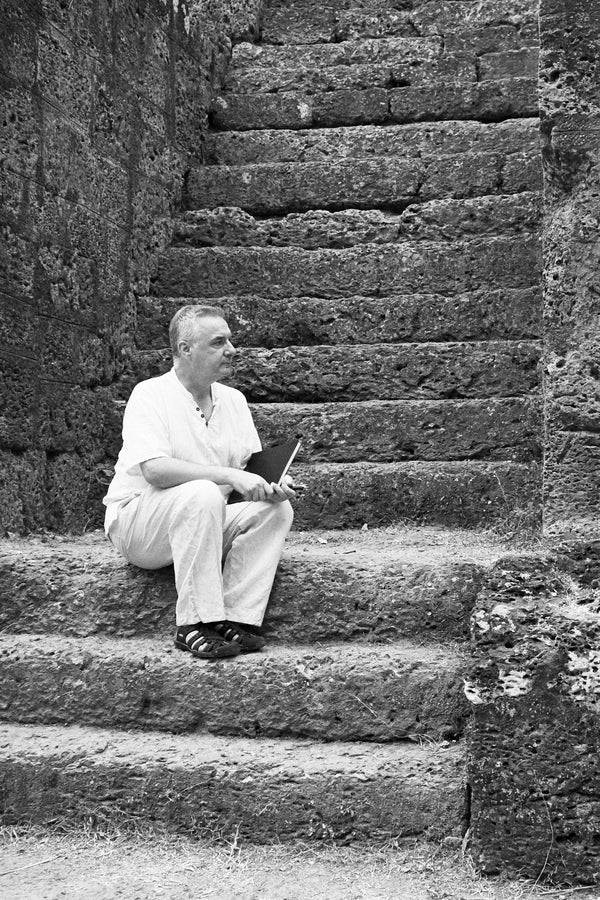Complimentary worldwide shipping on orders over $400 · No import tariffs for most countries
Complimentary worldwide shipping on orders over $400 · No import tariffs for most countries

The Serpent, the Thunderbolt, and the Sky
A Devotional Morning Among the Northern Shrines of Preah Khan
Preah Khan · Northern Temple · July 2025
When the gods sleep,
the stone remembers them—
and waits.
This morning, the forest rose before we did. Gibbons were already calling from high in the canopy as Annie and I arrived at the northern edge of Preah Khan. The path from the moat was quiet—softened by yesterday’s rain and stitched with birdsong. Leaves still cradled the night’s final droplets. We passed beneath the gopura and stepped into a breath older than time.
Preah Khan is not a monument—it is a layered remembering. Time folded into stone. Devotion carved into silence. While Ta Prohm may be better known, Preah Khan speaks more deeply to those who arrive without question. And today, in the northern temple, that silence spoke clearly. Even the birds seemed to hold their breath as we entered the precinct once offered to Shiva.
This northern sanctuary feels gentler than its southern kin—softer in its carvings, more inward in its spirit. Though Shiva presides here, Vishnu’s presence stirred in equal measure: cosmic, serene, vast. It did not feel like a temple of division, but of sacred consonance.
The first image to draw me was Vishnu, reclining upon Ananta, cradled in infinite sleep. The entire pediment was intact above a shadowed entrance—fish and turtle drifting below, Lakshmi seated at his feet, the lotus unbloomed. Brahma had not yet emerged. The world was still sleeping.

Vishnu dreams on the serpent of endlessness; Lakshmi keeps the world from slipping away
I took out my chalks and followed the line of the serpent with care. Each scale was a breath, each curve a turning of the wheel.
Across from it, high above the opposite portico, another pediment bore Shiva seated in still command. A thunderbolt hovered above his matted crown like an unseen mantra. On either side, Vishnu and Brahma formed the old triad. The stone beneath them had cracked. Even gods are held in time.
A moment later, Annie touched my arm and pointed to a wall nearby. Carved into a medallion was a strange and unsettling image: a bird of prey devouring a human corpse, its wings wrapped tightly like a funerary shroud. It was haunting, sacred, raw. Zhou Daguan’s words returned to me—of bodies laid in the open, of beasts as intermediaries. In that moment, I saw no horror, no defilement—only a ritual of return. We all go back to sky, eventually.

Sky devours flesh: the old rites of letting go
The light warmed. Lizards emerged. A vine-wrapped prayer flag stirred near a lintel. In another pediment, barely visible in shadow, a fierce god with eight arms battled two asuras. One he held by the wrist, the other by the hair—every gesture measured, not wrathful but exact. Krishna, I thought. Or Vishnu in another mood. The face was worn. But the hands still spoke.
Further along, we entered a corridor the builders never finished. Stone blocks lay marked but untouched, edges rough with red ochre. One window was half-hollowed—like a mantra begun but never uttered. It did not feel abandoned. It felt paused.
And then—beyond the rubble, on the pediment of a small library shrine—Krishna stood with one hand raised, lifting Mount Govardhana above his head. Beneath him, carved cattle and cowherds gathered close, spared from the storm. Indra’s fury, once unleashed, had been transformed into shelter. A divine defiance, rendered in grace.

Beneath the Weight of Heaven, the Stone Still Holds
The pediment had weathered much, but its centre held—Krishna still bearing the mountain, silent and sure. Around him, apsaras lingered in niches along the courtyard walls—smiling, eroded, or fading into stone. At the heart of the ruin, the library stood in quiet devotion, and the broken path still remembered every footfall once offered in prayer.
A vacant pedestal still held presence: once it bore Prajnaparamita, Buddha, and Lokeshvara. Now it held only air and memory. The absence had become the form. And the space remembered.
Before leaving, we passed one last pediment. Rama stood upon the Pushpaka chariot, bow in hand, Lakshmana and Sita at his sides. Below, hamsas spread their wings to lift him toward heaven. The stone trembled with stillness, waiting to fly.
I paused near the central stupa and remembered that this was once an imperial anchor—a city-temple at the heart of Jayavarman’s vision. But its defenses were thresholds. Its moats, initiatory. Even the naga balustrades seemed less guardians than metaphors—pulling inward toward the real.
The light had turned to gold. We made our way back through the eastern court, circled behind the great stupa, and returned to the northern gate. Our motorbike waited, quiet beneath the trees. We did not speak. The path home had already passed.
—
The gods do not speak
but they listen
through stone and rain.
In the uncarved edge of a wall
or the crack between figures
is the silence
we were meant to hear.
A hand holds a lotus.
A foot rests on a coiled world.
Even absence sings
when it has known worship.
The sacred sleeps,
but never forgets the breath
of those who came to kneel.
—
And still the stone listens, long after the voice has gone.
Sanctuary of the Sword and the Stillness
Photographs from Preah Khan Temple by Lucas Varro
Preah Khan is a temple of thresholds—built as both sanctuary and sword, palace and prayer. Once a centre of learning and devotion, its vast corridors unfold like a labyrinth of memory: lintels worn smooth by centuries of touch, roots winding through broken sanctums, light slipping like breath across the stones.
Constructed by Jayavarman VII to honour his father, Preah Khan holds within its crumbling grandeur a quiet tension—between ruin and reverence, conquest and compassion, emptiness and sacred trace. Here, silence gathers in chambers where dancers once swirled, and moonlight drapes across a still-standing stupa at the heart of the sanctuary.
In this contemplative collection from the Spirit of Angkor series, Lucas Varro brings his analogue cameras to the softened austerity of Preah Khan. Each photograph—captured on large or medium format black-and-white film, shaped by long exposure, chiaroscuro, and hand-toning—distils the temple’s presence into pure atmosphere. A devata faded but smiling. A doorway dissolving into mist. A single root embracing stone like prayer.
Printed in limited editions on museum-grade Hahnemühle Bamboo paper, each work is accompanied by a Collector’s Print Package including poetic writings, curatorial reflections, and field notes from the artist’s dawn pilgrimages through the temple’s sacred ruins.
This is Preah Khan not as relic, but as witness. A vast, breathing sanctum where stillness is the final inscription.
Join My Studio Journal
Receive occasional letters from my studio in Siem Reap—offering a glimpse into my creative process, early access to new fine art prints, field notes from the temples of Angkor, exhibition announcements, and reflections on beauty, impermanence, and the spirit of place.
No noise. No clutter. Just quiet inspiration, delivered gently.
Subscribe and stay connected to the unfolding story.

Join My Studio Journal
Receive occasional letters from my studio in Siem Reap—offering a glimpse into my creative process, early access to new fine art prints, field notes from the temples of Angkor, exhibition announcements, and reflections on beauty, impermanence, and the spirit of place.
No noise. No clutter. Just quiet inspiration, delivered gently.
Subscribe and stay connected to the unfolding story.































